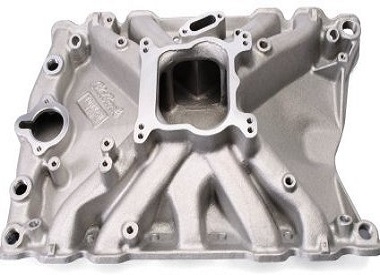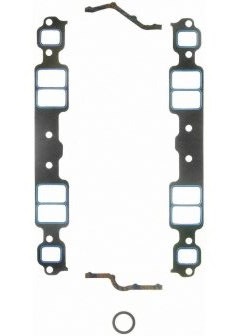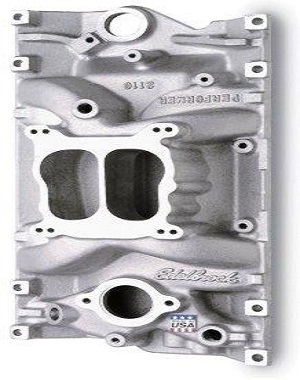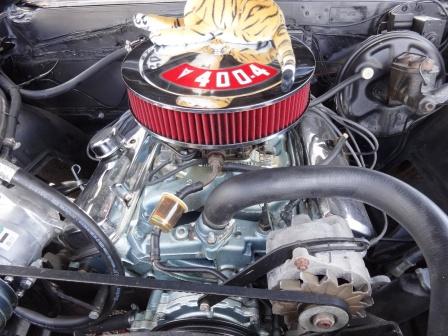
Switching over to a high-performance aluminum intake manifold remains one of the most popular upgrades among classic muscle car owners. The question becomes whether this is the right thing to do or not. To determine the answer to this question we first have to figure out what camp you hoist your flag in.
Automotive purists and vintage muscle car investors strive to keep every nut and bolt from the factory assembly line on the automobile. In fact, they might consider replacing the factory installed cast-iron intake with a high-performance aluminum intake manifold sacrilegious. Then we have the folks that buy these classic muscle cars to enjoy them. They want to drive them around and have fun while doing it.
From the vantage point of these people, replacing the inefficient and extremely heavy factory installed intake manifold makes a lot of sense. Nevertheless, I’m a believer that you can have your cake and eat it too. If you upgrade to an aluminum intake and save the original cast-iron one, with all of the original mounting hardware, you can satisfy both groups of people. Here we’ll talk about the different kinds of high-performance aluminum intake manifolds available. We’ll even get into the differences between single plane and dual plane intakes and which one is right for you. Finally, you’ll discover how much horsepower you can actually gain from this performance upgrade.
Types of Aluminum Intake Manifolds

When it comes to classic muscle cars there are only two types of intake manifolds. These include the single or dual plane design. Most people choose the dual plane, because the original cast-iron part utilized this design feature. Therefore, when upgrading to a high-performance aluminum intake manifold, of the dual plane variant, the car basically runs the same throughout the throttle range.
The dual plane set up incorporates a divided plenum allowing half the carburetor to feed four cylinders at a time on a V-8 engine. However, the main characteristic of the dual plane manifold includes long flowing runners. These runners are polished to a smooth finish that increases the flow rate over the stock component. The dual plane provides improved low-end power, while maintaining engine idle quality similar to the original equipment.
With a single plane high-performance aluminum intake manifold there’s no divider underneath the carburetor. This allows for all eight cylinders to feed at the same time. However, the big difference between this set up and the dual plane remains the length of the intake runners. With a single plane set up, the runners become much shorter. This provides a faster and more direct delivery of fuel to the cylinders.
This design increases engine efficiency at higher RPMs, but sacrifices idle quality. Therefore, a single plane manifold is considered best for racing applications. Now that we understand the difference between the two types let’s talk about the advantages of installing an aluminum intake manifold.
Improving the Power to Weight Ratio
One of the biggest differences between our classic muscle cars and modern automobiles is the power to weight ratio. Car makers have identified that reducing the vehicle’s total weight increases performance and fuel economy at the same time. The incredible part about their transformation into a lighter automobile is they actually provide better crash protection now. In some cases, these modern cars weigh more than 1000 pounds less than our beloved vintage automobiles. At the same time they get triple the fuel economy, provide better performance and hold up better in a crash.
We can learn from these advances and attempt to improve the power to weight ratio on our own automobile by reducing total weight. A muscle car like a Chevrolet Camaro Super Sport with a big block 396 cubic inch engine comes with a heavy cast-iron intake manifold. These original equipment parts weigh 75-100 pounds, depending on the design. An aluminum high-performance version comes in at less than 20 pounds. Therefore, this upgrade becomes a major weight reduction operation.
There’s also an interesting side effect from this swap. Since the intake manifold rides directly over the front springs of the automobile you get a surprising boost in the front ride height of the automobile. In many cases the front springs on our muscle cars are starting to get worn and tired. Reducing the weight that rides on top of them can put a little spring back in their step. As a result the car maintains a healthier looking ride height.
Power Increase from an Aluminum Intake Manifold

Although a high-performance aluminum intake looks pretty on the outside it’s really the inside that’s important. When the factory originally molded the cast iron intake installed on your engine they didn’t do the greatest job. Imperfections and bumps inside of the fuel runners reduce the efficiency of fuel and air flow to the cylinders. The aluminum intake not only weighs a lot less, but they buff it to a high polished finish inside.
This increases performance by facilitating efficient and higher amounts of fuel flow. The question that everybody wants to know is how much all this improvement means to the bottom line. In other words, how much horsepower will I gain from a high-performance aluminum intake manifold upgrade. Without getting too scientific we’ll attempt to answer this question. How much you gain depends on a variety of variables. The efficiency of the carburetor and the exhaust system become two major elements to consider.
In other words, the upgrading to an aluminum intake is enhanced with the replacement of the factory carburetor and exhaust manifolds. If you increase the carburetor size and the efficiency of the exhaust by installing headers you will receive the maximum benefit from replacing the intake. The combination of replacing these three high-performance components can net horsepower increases from 20 to 60 HP. An interesting side effect of this combination upgrade comes in at the fuel pump. Increasing the horsepower can also increase the fuel economy. With that said, increased fuel economy only comes with grand mom like throttle position. In other words, if you keep your foot off the floor you’ll also receive better fuel economy when you’re cruising around town.

